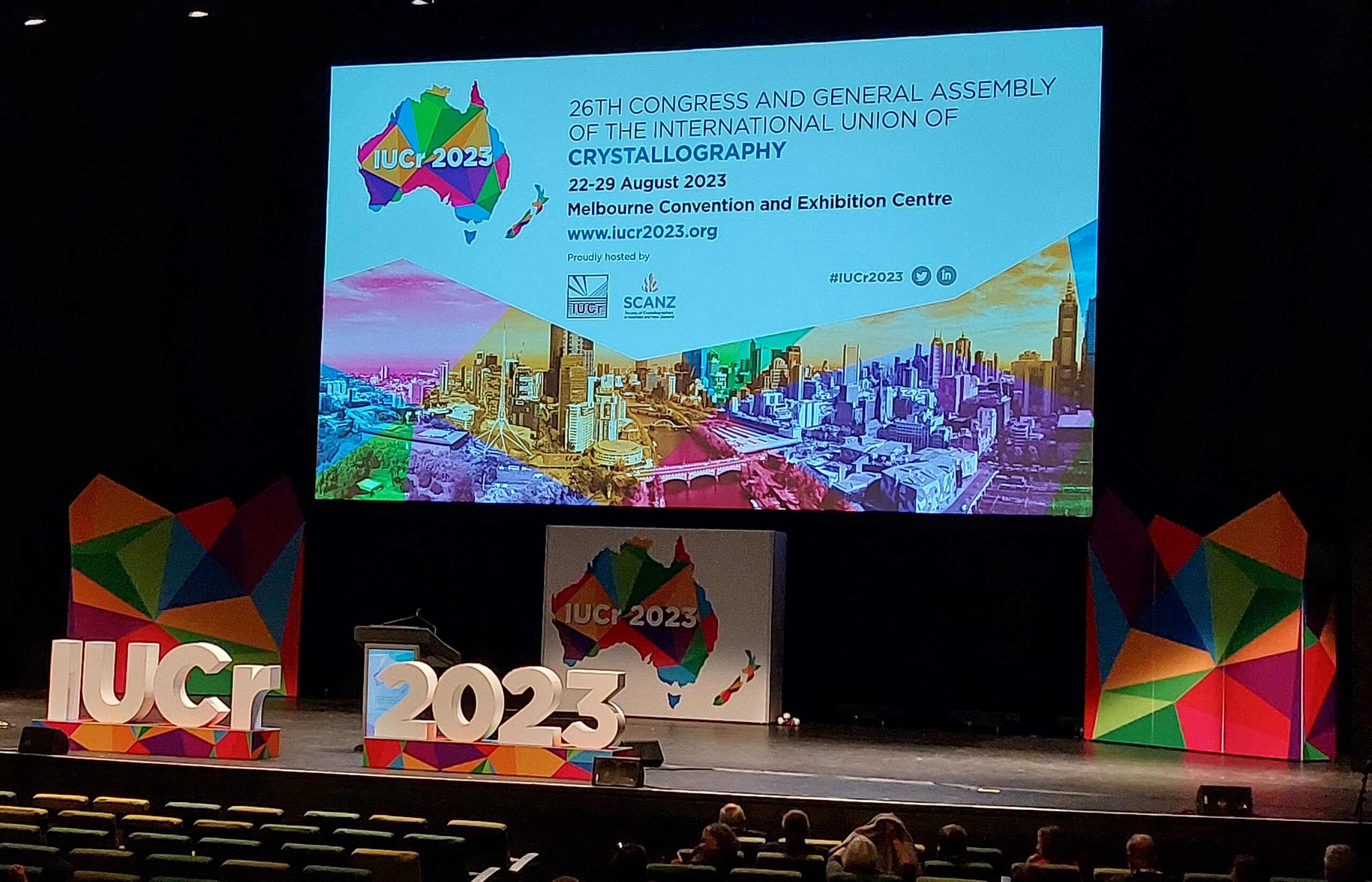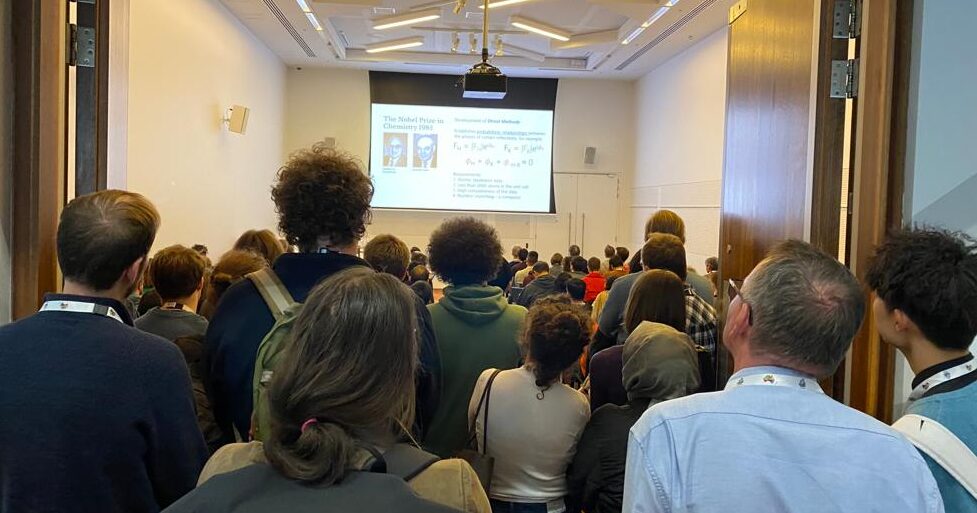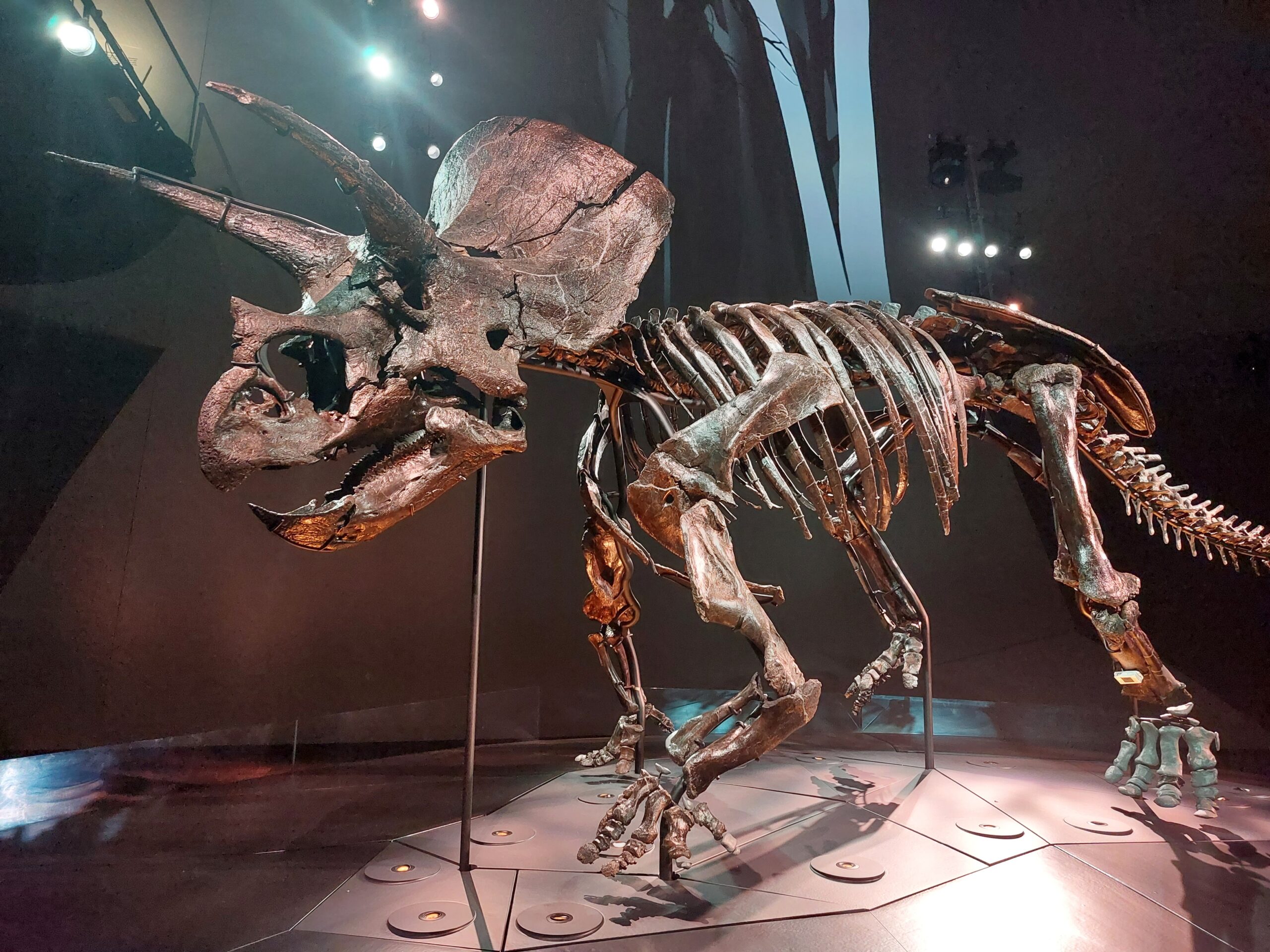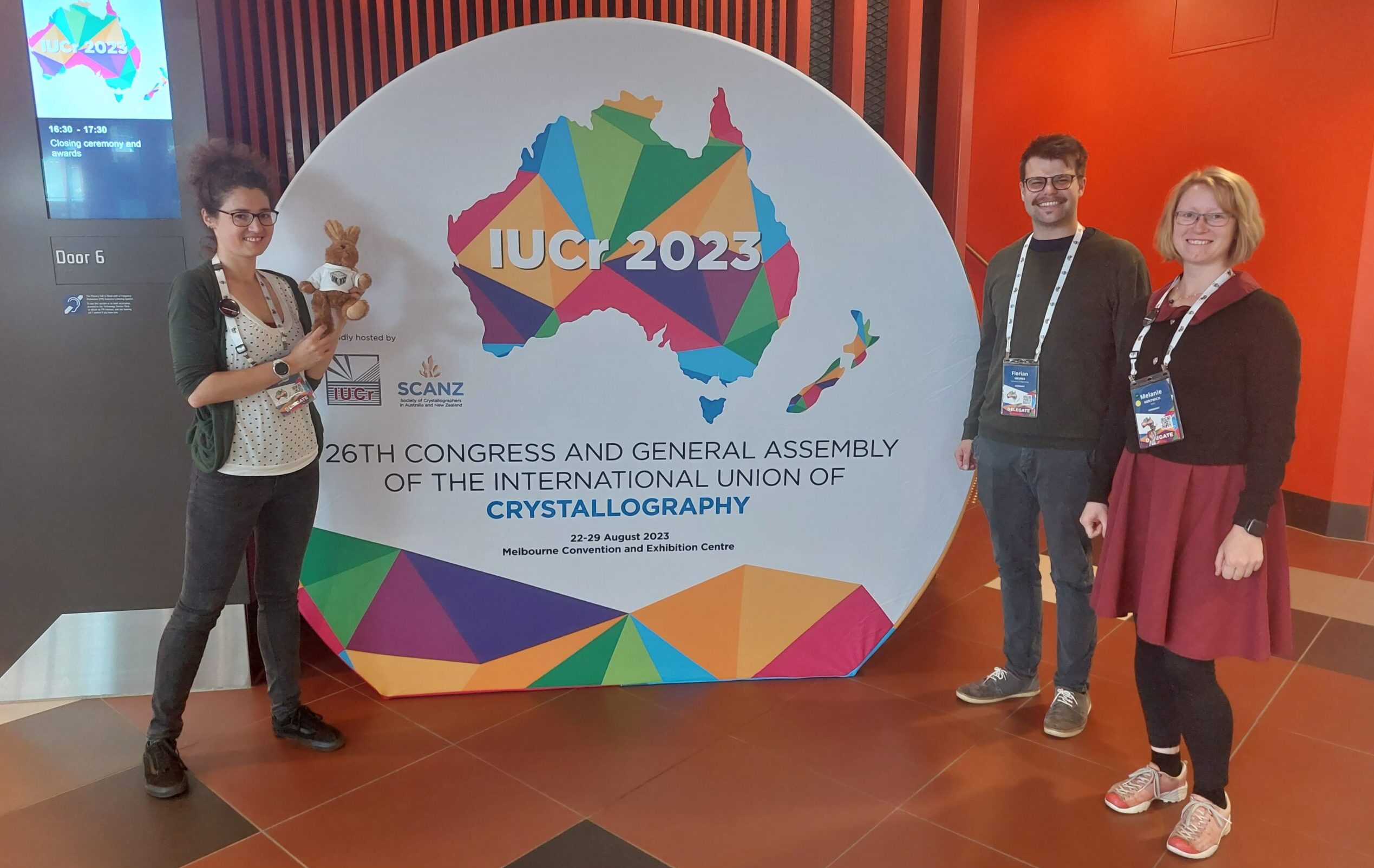by Florian Meurer and Tina Weigel
Dear Young Crystallographers,
We are Florian Meurer from the University of Regensburg and Tina Weigel from the TU Bergakademie Freiberg and we would like to take you with us on our journey to Melbourne, where the 26th IUCr Conference took place from 22.08. to 29.08.23.
Tina: Ever since I started my PhD at the Institute for Experimental Physics, my big goal was to go to the IUCr in Melbourne in 2023. Already at the beginning of my doctorate, I had heard about the conference from my colleagues and always said to myself: “you have to hang on until then”. On the 20th of August, the time had finally come and I was on the plane to Melbourne, thanks also to a travel grant from the DGK. Accordingly, I was full of anticipation at the opening session. Here is a photo with the great stage decoration.

I had been given the opportunity to present the results of my PhD, which is now in its final stages. This is also a good opportunity to practice for the upcoming defence. However, I have only given a few presentations so far and certainly not at such a big conference. That’s why I was really nervous before the talk. Florian, how did you find out about the ICUr?
Florian: Even over a year ago we were talking a lot in our working group about this mega crystallography conference on the other side of the world! Especially, since the last IUCr in Prague unfortunately ran digitally to a large extent, the interest in flying to Melbourne and taking part was, of course, immense. I already got there a few days beforehand and took part in the workshop on quantum crystallography and held parts of the Olex2 workshop myself. Both were super interesting and I got to meet a lot of new people from these communities. I was also particularly enthusiastic about the introductory event, which was very much characterised by the dance and music of the Australian indigenous people, but also about the exciting Ewald lecture by Wayne Hendrickson. But that was only the beginning! Tina, how was your talk?
Tina: It went really well. There were some technical issues uploading the presentation, but the technical support at the conference was really great, responded quickly, and soon found a solution. I gave a talk in the microsymposium “Functionality from Broken Inversion Symmetry” entitled “The structure of a ferroelectric, commensurate low temperature phase of YMn2O5“. Emma McCabe and Anthony Phillips ran the microsymposium with many friendly and warm words, creating a really pleasant atmosphere for all the presenters, which also helped to deal with the nervousness. Fittingly, I also had a supplementary slide ready for all the questions, which also left a positive impression. So it all went quite well and, as usual, I had too many doubts in advance. Florian, did you have a lecture or a poster and how was your presentation?
Florian: Wow that sounds great! I participated with a poster on quantum crystallography, as I didn’t know yet if I would be able to round up the topic until the conference. My topic was a comparison of different electron density modelling methods and what insights the results can provide into the chemistry of an organometallic compound. Of the many, many talks – there were, after all, more than 100 symposia – I particularly enjoyed the keynote lecture by Simon Grabowsky on wave function-based quantum crystallography and various talks on evaluating the Cambridge Crystallographic Database. However, the lecture by Anders Madsen on the topic of machine learning for structure solution also stood out for me. The room was completely overcrowded during his talk, as you can see in this photo.

Tina, what did you like best about the conference?
Tina: Oh well, there was a lot! The broad scientific programme was really great. In my opinion, it covered and reflected all areas of crystallography well. There were also contributions to areas where I would not have expected crystallography to make a contribution, such as space travel. I also liked the conference centre very much. It was difficult to find the lecture rooms at the beginning, but as soon as you knew your way around, it was no longer a problem. From there, you also had such a beautiful view of the Melbourne skyline on the Yarra River. Here, I’ll show you a photo from the poster session.

A big praise also goes to the organisers, for providing a really nice and familiar conference. Everything went off without any major problems, and in addition to the scientific exchange, leisure activities were also offered, such as guided tours of the surrounding area or you could help build a crystal structure and meet new people there. In general, I found the Australian nonchalance super pleasant and contagious. What did you think of the conference?
Florian: I can also contribute a photo to the poster session! Here you can see me in front of my poster.

Otherwise, I can only agree with you. There was a great atmosphere at and away from the conference. And what was your impression of the Social events? We heard a lot about the Dectris event, where no expense or effort was spared to create an unforgettable evening. One of Rigaku’s events even took place at the zoo! Unfortunately, I didn’t make it to any of the evening events and I also had to cancel the conference dinner at short notice due to a one-day illness. However, I did participate in the Rigaku “Fun Run”, which was a five-kilometre run through the Queen Victoria Gardens in the morning. New personal record for me – the Australian climate was really very pleasant! How did you like it, were you able to go to a corporate event?
Tina: Unfortunately, I didn’t attend any of the company events. I was too nervous about my presentation. But I found the Welcome Reception very nice. There was a small animal show with native animals where you really learned something about the Australian animal world and you were welcomed to Australia with a kangaroo in a replica pouch. The animals belonged to a Wild Life Sanctuary, where orphaned and injured animals are cared for until they can, unfortunately only partially, be released back into the wild. The conference dinner at the Melbourne Museum was also really cool. You had the opportunity to walk through the exhibitions and look at dinosaur skeletons, for example. Look here…

Unfortunately, you had to wait in queue for quite a while at the buffet and so you couldn’t really enjoy the exhibition, the band, and the DJ. But choosing a museum as the venue was a great idea. Did you have some time to explore the city on the side?
Florian: Yes, it was great. Thanks to the great location of the conference centre, you were right in the middle of the action! Especially the city at night and the Victoria Southern Market have remained very vivid in my memory. Here are two impressions of the colourful city by day & night:


And You?
Tina: I was mainly out and about in the evenings after the conference or during the breaks near the conference centre. I also went to the Victoria Market, for example. As the conference programme was very full and tight, it was not easy to see much of the city. But every now and then there only were sessions not so interesting to me, so I could go and watch a rugby match or go on an excursion.
Did you have the opportunity to forge a few new contacts?
Florian: Yes, absolutely! As it looks at the moment, two promising collaborations have even emerged from the contacts. How was it with you?
Tina: After I gave the presentation to advertise for IUCr 2029 in Berlin at the General Assembly with Manfred Weiss from Helmholtz Zentrum Berlin, many people suddenly knew my face and wanted to know more about Berlin and Germany. That made it possible to talk to a lot of people. Apart from that, I was very happy to see many familiar faces and also found it very good that the DGK was so strongly represented. We both helped out at the DGK stand and drummed up publicity for Berlin 2029. In any case, I am very pleased that Berlin has won the bid for IUCr 2029 and that I was able to support it. It was also nice that Melanie Nentwich from DESY made it to the conference and we were able to take a photo with our young crystallographer mascot.

In general, I must say that I enjoyed the conference very much and was able to take away a lot from the presentations of the other participants. The interaction was positive throughout, the quality of the contributions was excellent, and I think that every area of crystallography was comprehensively represented. I also received a lot of positive feedback on my presentation, so that I returned home full of motivation and zest for action. What is your final conclusion?
Florian: I had a very great time in Melbourne with many new impressions, faces and concepts. The organisers succeeded in creating a really impressive conference, for which they can only be congratulated. I was particularly surprised by the presence of indigenous culture in everyday life in Australia, whether at the conference or in the city. All in all, it was a culturally and academically very formative experience for me and I am also very happy that I was able to finance this trip with a travel grant from the DGK. Tina, thank you very much for the talk!
Tina: Oh, sounds good. It was nice to chat with you, Florian